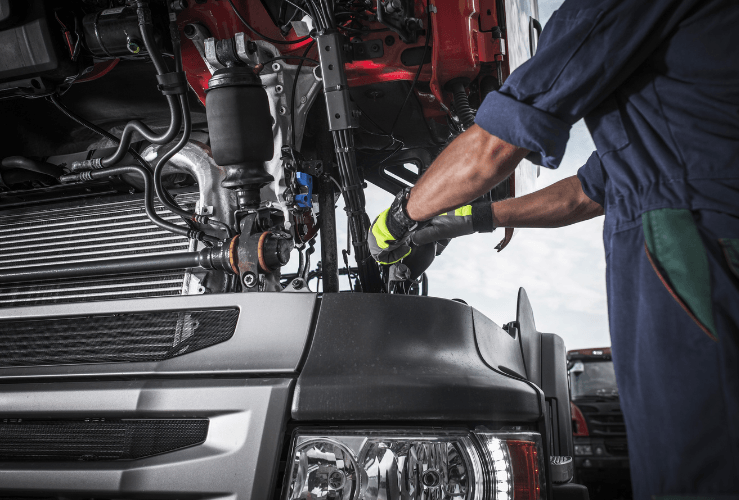Managing a fleet is no easy task, whether it's a food delivery firm, a haulage company, or a public sector entity.
Efficiency is at the heart of all successful fleets, and in recent years a host of new technologies - such as driver management systems - have emerged to make achieving this goal easier.
But efficient business fleet management also involves some tasks that have changed little over the decades - including certain manual safety inspections.
Here are 10 ways you can optimise your fleet's efficiency, with a view to delighting customers, keeping your drivers safe - and protecting your bottom line.

1. Reducing fuel usage/wastage
One of your organisation's biggest outgoings is fuel, so it makes sense to find ways to reduce usage where possible.
In an ideal world, fleet drivers would always take the most efficient route - but this isn’t an ideal world. One solution is to use GPS technology to monitor the routes they take, and then offer constructive feedback if they are getting from A to B - via C, D or E!
A range of fleet management software is now on the market that can help with such monitoring, particularly in relation to fuel economy. These packages can identify issues such as excessive idling (which can waste a lot of fuel), and inefficient acceleration and braking.
Having pinpointed issues, you can guide and train your drivers to adopt more efficient behaviours. Indeed, the notion of managing drivers is intrinsically linked to managing fuel consumption.

2. Preventive maintenance/inspection schedule
Scheduled fleet vehicle maintenance can help pinpoint relatively minor issues before they flare up into larger and more costly ones.
And as is so often the case these days, technology can make it easier to spot problems early on. Remote diagnostic systems are available that use sensors which can send a warning if one of the vehicle's systems is not operating as expected.
For fleets that don't harness remote diagnostics systems, adhering to a more traditional, hands-on inspection schedule is a workable alternative.
By taking a preventive approach to your fleet maintenance you will avoid the larger repair bills associated with serious issues, and reduce or even eliminate vehicle downtime - which can be critical for busy fleets.
3. Replace parts promptly
If an issue with a part has been identified by your software system, it’s important to replace it as soon as possible. Doing so will drastically reduce the chances of a breakdown - and it may help prevent related parts developing faults, or causing other damage to the vehicle.
Additionally, if you know roughly how long a part will last, it makes sense to buy it in advance, or even swap it out as it approaches the expected end of its lifespan.
For example, if you know your lorries' starter motors last about 100,000 miles, you might replace it after 80,000 miles.

4. Plan efficient routes
Getting goods or supplies to their destination on time is critical for maintaining a good reputation.
You can harness the latest map software - such as GPS satnavs of Google Maps - to plan the most direct route to a drop-off point, and identify any congestion or roadworks (which may require a re-route). You can also employ real-time customer notifications to change delivery plans if required.
As well as making your service more efficient, using these approaches will reduce stress on your all-important drivers.
Ultimately, effective route planning is at the heart of fleet driver management.
5. Harness real-time GPS tracking
Before GPS systems were widely adopted by the fleets, managers had to keep track of their vehicles using mobile phones. And before that, drivers had to read old-fashioned printed maps and learn their routes, with little if any contact with head office.
Thankfully, today we do have GPS technology, which helps fleet managers pinpoint exactly where their vehicles are, and therefore advise customers of any delays.
These systems can also help managers organise breakdown recovery assets and send them to the required locations, following a mechanical fault.
6. Invest in quality fleet management software
The old days of whiteboards and paper schedules are long gone - or at least they should be! Today's fleet driver management systems/software is invaluable in improving fleet efficiency and maintaining contact with employees.
An effective piece of fleet management software will store a range of useful information, including vehicle records, driver information, present location, and maintenance problems. You can also monitor driver behaviours, pinpoint congested areas, and enhance the safety of team members.
Some of these technologies may also offer pointers on how to conserve fuel (and reduce costs), and deliver real time notifications to drivers if their vehicle is suffering a fault.
7. Maintain a schedule
Well organised scheduling can support you in the management of orders, deliveries and assignments - whether you decide to harness web-based software or not.
Scheduling helps track planned, re-routed, or high priority deliveries, as well as identify which vehicles are available at a given time.

8. Keep tyres in excellent condition
Just as with any kind of vehicle, fleet managers should undertake regular tyre checks.
The minimum tyre tread depth in the UK is 1.6mm, although many manufacturers recommend replacement after the 3mm mark. Maintaining tyre conditions of business vehicles is an obvious but critical task among vehicle fleet management best practices.
Tyre inspections are one task that must still be accomplished manually; even the most advanced fleet technologies cannot remotely check for sub-standard tyres. That said, the process can be made easier with a tyre tread depth gauge.
9. Take advantage of mobile apps
A number of communication apps are available that help with managing drivers and assets, and receiving updates. These apps can connect with fleet management software, track deliveries and driver/vehicle locations, as well as access vehicle information and make reporting issues easy.
Mobile apps can also support the management - or automation - of things like invoices, billing, route planning, and scheduling.
When used well, these apps can help your fleet operate more quickly and efficiently.

10. Provide ongoing training to drivers
Your drivers are the lifeblood of your fleet, so it makes sense to provide them with relevant training.
Certain training programs may focus on aspects such as safety, or awareness of the latest road traffic regulations.
Other courses might upskill drivers so they can drive larger vehicles.
Looking for business breakdown cover?
At Start Rescue, we offer comprehensive business breakdown cover to keep your business vehicles on the road, whether you have a single van or a large commercial fleet. Enjoy reliable protection for cars, motorcycles, vans, and more, ensuring your business stays productive.



